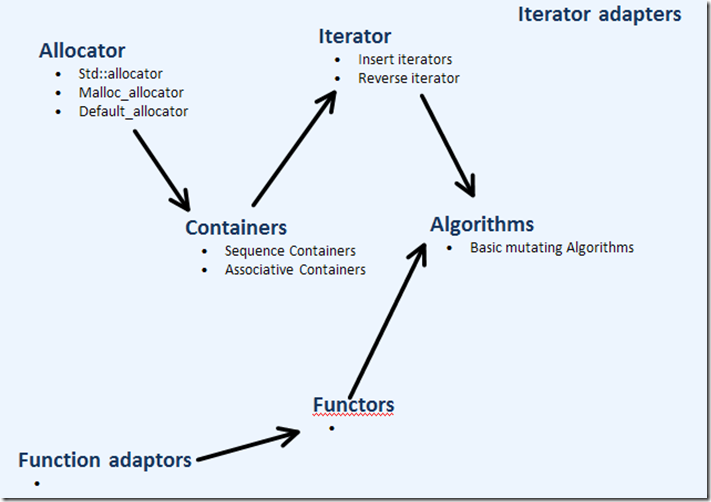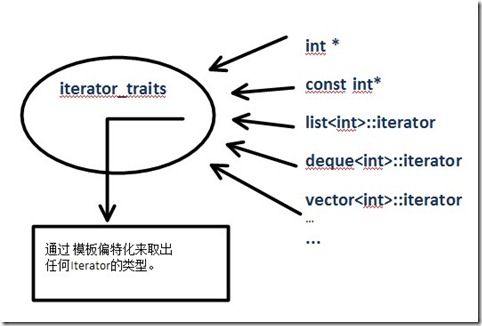之前一直希望能够看STL源代码,因为他一直存放在我的硬盘深处。但是由于复杂性,我一直再绕。而且纠结的是,我一直推荐我的学弟去研读STL。由于最近的工作需要,使我不得不一看STL的究竟。当然,STL对我来说依然是太庞大了,有相当多的相关的基础知识的缺乏导致整个过程实在是太艰难了,直到我看到了《SGI STL 源码剖析》。之后我的很多例子其实就是这本书的源代码。真的,这又是一本经典的著作。这本书贯穿了我整个STL的学习。当然,如果你之前研读过《inside c++ object model》等经典C++教材。你会发现。整个知识开始网罗了。
按照道理来讲,学习STL,实在是不能不从总图开始。但是STL太庞大了。这个总图只是一个残缺的部分。按照常规的思路,的确是需要从总纲学,但是,真的,我不能在这里胡扯。为了更方便自己理解。我从Iterator开始。
从这个图中可以看出,Algorithm 通过 Iterator 访问 Container,而我们很多面向container的操作同样是有Iterator出发的。所以,我也准备从这里入手。

制作一个Iterator,我们首先遇到的一个问题,就是如何找到这个Iterator 指向的类型。
1、根据参数推导,我们可以找出参数类型,但是,如果是返回值,我们则无能为力。
#include <iostream>
using namespace std;
template <class I, class T>
void func_impl(I iter, T t)
{
T tmp = t;
cout<<tmp<<endl;
}
template <class I>
inline
void func(I iter)
{
func_impl(iter, *iter);
}
int main()
{
int i = 9;
func(&i);
}
2、通过声明内嵌类型。我们可以找到这个Iterator的类型
#include <iostream>
using namespace std;
template <class T>
struct MyIter
{
typedef T value_type;
T* ptr;
MyIter(T* p = 0):ptr(p){}
T& operator*()const {return *ptr;}
};
template <class I>
typename I::value_type
func(I ite){return *ite;}
int main()
{
MyIter<int> iter(new int(8));
cout<<func(iter)<<endl;
delete iter.ptr;
iter.ptr = NULL;
}
但是,我们并没有解决问题,如果这个Iterator 指向的地方,不是一个class type。原生指针不是,所以,我们必须找到一个方式这个就是 template partial specialization。
#include <iostream>
using namespace std;
template <class I>
struct iterator_traits
{
typedef typename I::value_type value_type;
};
template <class T>
struct iterator_traits<T*>
{
typedef T value_type;
};
template <class T>
struct iterator_traits<const T*>
{
typedef T value_type;
};
template <class I>
typename iterator_traits<I>::value_type
func(I iter){return *iter;}
int main()
{
int i = 50;
cout<<func(&i)<<endl;
}
构造一个Iterator,我们必须有的部分。
struct iterator {
typedef _Category iterator_category;//Iterator种类
typedef _Tp value_type; //iterator 所指对象类型
typedef _Distance difference_type; //2个Iterator之间的距离
typedef _Pointer pointer; //iterator 所指对象的地址
typedef _Reference reference; //Iterator 所指对象引用类型
};
template <class _Iterator>
struct iterator_traits {
typedef typename _Iterator::iterator_category iterator_category;
typedef typename _Iterator::value_type value_type;
typedef typename _Iterator::difference_type difference_type;
typedef typename _Iterator::pointer pointer;
typedef typename _Iterator::reference reference;
};
对于原生指针,需要适应特化版本。这里从略。

SGI STL 增加元素之一 __type_traits
从字面上看,这里是类型萃取。的确。这里是对 trivial default constructor 和 none trivial defaultconstructor 的区别。 以及 none-trivial assignment operator 。 non-trivial-dtor。相关的知识可以在《inside c++ object model》中找到。在面对拥有”无用”的构造,拷贝,复制等类时,通过萃取机制,可以在编译时完成函数绑定。会直接采用最有效的策略。采用更为高效的memcpy等。 为了构造能够在编译时完成函数绑定,我们只能利用重载机制,那么,我们也就必须构造类型,作为函数参数
struct __true_type {
};
struct __false_type {
};
template <class _Tp>
struct __type_traits {
typedef __true_type this_dummy_member_must_be_first;
/* Do not remove this member. It informs a compiler which
automatically specializes __type_traits that this
__type_traits template is special. It just makes sure that
things work if an implementation is using a template
called __type_traits for something unrelated. */
/* The following restrictions should be observed for the sake of
compilers which automatically produce type specific specializations
of this class:
- You may reorder the members below if you wish
- You may remove any of the members below if you wish
- You must not rename members without making the corresponding
name change in the compiler
- Members you add will be treated like regular members unless
you add the appropriate support in the compiler. */
typedef __false_type has_trivial_default_constructor;
typedef __false_type has_trivial_copy_constructor;
typedef __false_type has_trivial_assignment_operator;
typedef __false_type has_trivial_destructor;
typedef __false_type is_POD_type;
};
SGI 为每一个内嵌类型都定义为默认__false_type。这样来保证最底线的正确。因为如果判断错误则会有致命的错误。
然后为每一个标准类型设计特化版本。从而里引用偏特化机制来保证整个机制运行。比如
__STL_TEMPLATE_NULL struct __type_traits<char> {
typedef __true_type has_trivial_default_constructor;
typedef __true_type has_trivial_copy_constructor;
typedef __true_type has_trivial_assignment_operator;
typedef __true_type has_trivial_destructor;
typedef __true_type is_POD_type; // plain old data
};
template <class _ForwardIter, class _Size, class _Tp>
inline _ForwardIter
uninitialized_fill_n(_ForwardIter __first, _Size __n, const _Tp& __x)
{
return __uninitialized_fill_n(__first, __n, __x, __VALUE_TYPE(__first));
}
template <class _ForwardIter, class _Size, class _Tp, class _Tp1>
inline _ForwardIter
__uninitialized_fill_n(_ForwardIter __first, _Size __n, const _Tp& __x, _Tp1*)
{
//这里根据传入的类型_Tp1,得到了is_POD_type 类型。并定义了一个类型_Is_POD
//通过_Is_POD()构造一个临时对象,并传入函数参数。
typedef typename __type_traits<_Tp1>::is_POD_type _Is_POD;
return __uninitialized_fill_n_aux(__first, __n, __x, _Is_POD());
}
//_Is_POD 类型 == __true_type 执行
//这里其实,并没有调用构造函数。
template <class _ForwardIter, class _Size, class _Tp>
inline _ForwardIter
__uninitialized_fill_n_aux(_ForwardIter __first, _Size __n,
const _Tp& __x, __true_type)
{
return fill_n(__first, __n, __x);
}
//_Is_POD 类型 == __false_type 执行
//这里,我们可以看出,在构造多个函数的时候,这里采用了c++的异常处理,保证如果有异常出现,
//构造过的对象能够被析构掉。当然,那个被构造了一半的对象是不会被析构的,也可能会造成memory leak,所以,切忌不要
//在构造函数中抛出异常。
template <class _ForwardIter, class _Size, class _Tp>
_ForwardIter
__uninitialized_fill_n_aux(_ForwardIter __first, _Size __n,
const _Tp& __x, __false_type)
{
_ForwardIter __cur = __first;
__STL_TRY {
for ( ; __n > 0; --__n, ++__cur)
construct(&*__cur, __x);
return __cur;
}
__STL_UNWIND(destroy(__first, __cur));
}
//类似的这样的,还有许多特化后的版本。这里从略。
类似这样的设计,充斥在SGI STL中,在这里,任何一个小小的开销都被认为是无法接受的。的确。这里给人一种真实的理想的世界。如果你对code 有洁癖,SGI STL,是不能错过的。